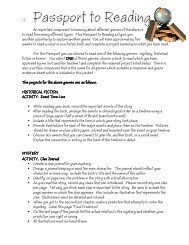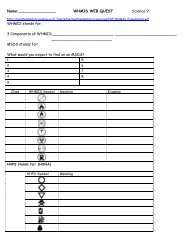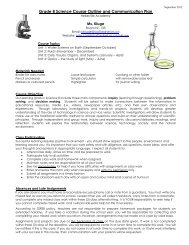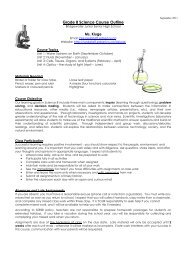1 Unit 4 â Conservation of Mass and Stoichiometry
1 Unit 4 â Conservation of Mass and Stoichiometry
1 Unit 4 â Conservation of Mass and Stoichiometry
You also want an ePaper? Increase the reach of your titles
YUMPU automatically turns print PDFs into web optimized ePapers that Google loves.
<strong>Unit</strong> 4 – <strong>Conservation</strong> <strong>of</strong> <strong>Mass</strong> <strong>and</strong> <strong>Stoichiometry</strong><br />
7-1 Chemical Names <strong>and</strong> Formulas<br />
I. Significance <strong>of</strong> a Chemical Formula<br />
A. Molecular formulas<br />
1. Number <strong>of</strong> atoms <strong>of</strong> each element in one molecule <strong>of</strong> a compound<br />
C 2 H 6 = ethane (2 carbon atoms, 6 hydrogen atoms)<br />
B. Ionic Compounds<br />
1. Represents the simplest whole number ratio <strong>of</strong> the compounds cations <strong>and</strong> anions<br />
Al 2 (SO 4 ) 3 = aluminum sulfate (2 aluminum ions, 3 sulfate ions)<br />
II.<br />
Monatomic Ions<br />
A. Monatomic ions<br />
1. Ions formed from a single atom<br />
B. Naming Monatomic Ions<br />
1. Monatomic cations are<br />
a. Identified by the element’s name<br />
2. Monatomic anions<br />
a. Drop the ending <strong>of</strong> the element name<br />
b. Add an “–ide” ending<br />
III.<br />
Binary Ionic Compounds<br />
A. Binary Compounds<br />
1. Compounds composed <strong>of</strong> two different elements<br />
B. Writing Formulas for Binary Ionic Compounds<br />
1. Write the symbols for the ions side by side. ALWAYS write the cation first!<br />
2. Cross over the charges by using the absolute value <strong>of</strong> each ion’s charge as the subscript for the other<br />
ion<br />
3. Check that the subscripts are in smallest whole number ratio<br />
C. Naming Binary Ionic Compounds from Their Formulas<br />
1. Name the cation<br />
2. Name the anion<br />
D. The Stock System <strong>of</strong> Nomenclature<br />
1. Roman numerals are used to denote the charge <strong>of</strong> metals that can form two or more cations.<br />
2. The numeral is enclosed in parentheses <strong>and</strong> placed immediately after the metal name<br />
a. Iron(II) <strong>and</strong> Iron(III), pronounced “iron two” <strong>and</strong> “iron three”<br />
3. Roman numerals are never used:<br />
a. For anions<br />
b. For metals that form only one ion<br />
1
E. Compounds Containing Polyatomic Ions<br />
1. Oxyanions<br />
a. Polyatomic anions that contain oxygen<br />
2. Naming a series <strong>of</strong> similar polyatomic ions<br />
ClO - -<br />
ClO 2<br />
-<br />
ClO 3<br />
-<br />
ClO 4<br />
Hypochlorite Chlorite Chlorate Perchlorate<br />
3. Naming compounds containing polyatomic ions<br />
a. Same as for monatomic ions<br />
4. Writing formulas including polyatomic ions<br />
a. Use parentheses when you need MORE THAN one <strong>of</strong> a polyatomic ion<br />
b. Parentheses are NEVER used for monatomic ions, regardless <strong>of</strong> how many are in the<br />
formula<br />
IV.<br />
Naming Binary Molecular Compounds<br />
A. Binary Molecular Compounds<br />
1. Covalently bonded molecules containing only two elements, both nonmetals<br />
B. Naming<br />
1. Least electronegative element is named first<br />
2. First element gets a prefix if there is more than 1 atom <strong>of</strong> that element<br />
3. Second element ALWAYS gets a prefix, <strong>and</strong> an “-ide” ending<br />
Examples: N 2 O 3 = dinitrogen trioxide<br />
CO = carbon monoxide, not monocarbon monoxide<br />
Table 7-3<br />
Numerical Prefixes<br />
Number 1 2 3 4 5 6 7 8 9 10<br />
Prefix mono di tri tetra penta hexa hepta octa nona deca<br />
7-3 Using Chemical Formulas<br />
I. Formula <strong>Mass</strong>es<br />
A. Formula <strong>Mass</strong><br />
1. The sum <strong>of</strong> the average atomic masses <strong>of</strong> all the atoms represented in the formula <strong>of</strong> a molecule,<br />
formula unit, or ion<br />
Formula <strong>Mass</strong> <strong>of</strong> glucose, C 6 H 12 O 6 :<br />
C = 12.01 amu 6 x 12.01 amu = 72.06 amu<br />
H = 1.01 amu 12 x 1.01 amu = 12.12 amu<br />
O = 16.00 amu 6 x 16.00 amu = 96.00 amu<br />
Formula <strong>Mass</strong> = 180.18 amu<br />
B. Molar <strong>Mass</strong>es<br />
1. A compound's molar mass is numerically equal to it formula mass, but expressed in units <strong>of</strong><br />
grams/mole (g/mol)<br />
Molar <strong>Mass</strong> <strong>of</strong> glucose, C 6 H 12 O 6 = 180.18 g/mol<br />
II.<br />
Molar <strong>Mass</strong> as a Conversion Factor<br />
A. Converting moles <strong>of</strong> compound to grams<br />
Amount in moles x molar mass(<br />
g / mol)<br />
= <strong>Mass</strong><br />
in<br />
grams<br />
B. Converting grams <strong>of</strong> compound to mass<br />
1<br />
<strong>Mass</strong> in grams x<br />
=<br />
molar mass(<br />
g / mol)<br />
Amount<br />
<strong>of</strong><br />
moles<br />
2
III.<br />
Percentage Composition<br />
A. Percentage Composition<br />
1. The percentage by mass <strong>of</strong> each element in a compound<br />
<strong>Mass</strong><br />
<strong>of</strong> element in 1<br />
molar mass <strong>of</strong><br />
mol <strong>of</strong> compound<br />
compound<br />
x<br />
100 = %<br />
element<br />
in<br />
compound<br />
B. Hydrates<br />
1. Crystalline compounds in which water molecules are bound in the crystal structure<br />
Copper (II) sulfate pentahydrate<br />
CuSO 4 • 5H 2 0<br />
a. The raised dot means "Water is loosely attached" It does NOT mean multiply when<br />
determining formula weight<br />
8-1 Describing Chemical Reactions<br />
I. Introduction<br />
A. Reactants<br />
1. Original substances entering into a chemical rxn<br />
B. Products<br />
1. The resulting substances from a chemical rxn<br />
Reactants Products<br />
C. Chemical Equation<br />
1. Represents with symbols <strong>and</strong> formulas, the identities <strong>and</strong> relative amounts <strong>of</strong> the reactants <strong>and</strong><br />
products in a chemical rxn<br />
II.<br />
Indications <strong>of</strong> a Chemical Reaction<br />
A. Evolution <strong>of</strong> Heat <strong>and</strong> Light<br />
1. Evidence <strong>of</strong> energy being released (exothermic rxn)<br />
B. Production <strong>of</strong> a Gas<br />
1. CO 2 , H 2 , H 2 S are some gases produced by chemical rxns<br />
FeS(aq) + H 2 SO 4 (aq) FeSO 4 (aq) + H 2 S(g)<br />
C. Formation <strong>of</strong> a Precipitate<br />
1. Precipitate is a solid that is produced as a result <strong>of</strong> a chemical rxn in solution<br />
BaCl 2 (aq) + Na 2 SO 4 (aq) 2NaCl(aq) + BaSO 4 (s)<br />
III.<br />
Characteristics <strong>of</strong> Chemical Equations<br />
A. The equation must represent known facts<br />
1. This can be done with a word equation:<br />
"hydrogen reacts with oxygen to form water"<br />
Hydrogen + Oxygen Water<br />
B. The equation must contain the correct formulas for reactants <strong>and</strong> products<br />
1. This is done with a formula equation<br />
H 2 + O 2 H 2 O<br />
C. The law <strong>of</strong> conservation <strong>of</strong> atoms must be satisfied<br />
1. Balancing is done with coefficients - small whole numbers that appear in front <strong>of</strong> a formula<br />
2H 2 + O 2 2H 2 O<br />
3
D. Additional symbols used in Chemical equations<br />
Table 8-2<br />
Symbol<br />
(s)<br />
(l)<br />
(aq)<br />
(g)<br />
∆<br />
Symbols Used in Chemical Equations<br />
Explanation<br />
"yields" ; indicates result <strong>of</strong> a rxn<br />
Used in place <strong>of</strong> a single arrow to indicate a reversible rxn<br />
Reactant or product in the solid state. Also a precipitate<br />
Reactant or product in the liquid state.<br />
Reactant or product in an aqueous solution (dissolved in water)<br />
Reactant or product in the gaseous state<br />
Reactants are heated<br />
2 atm Pressure at which the rxn is carried out, in this case 2 atmospheres<br />
Pressure<br />
Pressure at which rxn is carried out exceeds normal atmospheric pressure<br />
25 °C Temperature at which the rxn is carried out, in this case 25 °C<br />
MnO 2<br />
Formula <strong>of</strong> catalyst, in this case manganese dioxide, used to alter the rate <strong>of</strong><br />
the reaction<br />
IV.<br />
Significance <strong>of</strong> a Chemical Reaction<br />
A. Quantitative Information<br />
1. # <strong>of</strong> moles, atoms, molecules in a reaction<br />
2. Equality exists in each direction<br />
3. The fact that a rxn can be written does not mean that the rxn can take place<br />
V. Balancing Chemical Equations<br />
A. Identify the names <strong>of</strong> reactants <strong>and</strong> products, <strong>and</strong> write a word equation<br />
B. Write a formula equation by substituting correct formulas for the names <strong>of</strong> the reactants <strong>and</strong> the products<br />
C. Balance the formula equation according to the law <strong>of</strong> conservation <strong>of</strong> atoms<br />
D. Count atoms to be sure that the equation is balanced<br />
8-2 Types <strong>of</strong> Chemical Reactions<br />
I. Synthesis Reactions (Composition Rxns)<br />
A. Synthesis Rxns<br />
1. Two or more substances combine to form a more complex substance<br />
A + X AX<br />
B. Types <strong>of</strong> Synthesis Rxns<br />
1. Metals react with oxygen to form oxides<br />
4Al(s) + 3O 2 (g) 2Al 2 O 3 (s)<br />
2. Metals react with sulfur to form<br />
8Ba(s) + S 8 (s) 8BaS(s)<br />
3. Nonmetals react with oxygen to form oxides<br />
C(s) + O 2 (g) CO 2 (g)<br />
4. Metals react with halogens to form salts (halogen means "salt maker")<br />
2Na(s) + Cl 2 (g) 2NaCl(s)<br />
5. Active metal oxides react with water to form metallic hydroxides<br />
MgO(s) + H 2 O(l) Mg(OH) 2 (s)<br />
6. Nonmetal oxides react with water to form oxyacids (acid rain)<br />
SO 2 (g) + H 2 O H 2 SO 3 (aq)<br />
4
II.<br />
III.<br />
IV.<br />
Decomposition Reactions<br />
A. Decomposition Rxns<br />
1. One substance breaks down to form two or more simpler substances<br />
AX A + X<br />
B. Six Kinds <strong>of</strong> Decomposition Rxns<br />
1. Metallic carbonates, when heated, form metallic oxides <strong>and</strong> carbon dioxide<br />
CaCO 3 (s) CaO(s) + CO 2 (g)<br />
2. Metallic hydroxides , when heated, decompose into metallic oxides <strong>and</strong> water<br />
Ca(OH) 2 (s) CaO(s) + H 2 O(g)<br />
3. Metallic chlorates, when heated, decompose into metallic chlorides <strong>and</strong> oxygen<br />
2KClO 3 (s) 2KCl(s) + 3O 2 (g)<br />
4. Some acids, when heated, decompose into nonmetallic oxides <strong>and</strong> water<br />
H 2 SO 4 (aq) H 2 O(l) + SO 3 (g)<br />
5. A few oxides, when heated, decompose<br />
2PbO 2 (s) 2PbO(s) + O 2 (g)<br />
6. Some decomposition rxns are produced by an electric current<br />
2NaCl(s) 2Na(s) + Cl 2 (g)<br />
Single-Replacement Reactions<br />
A. Single-Replacement Rxns I<br />
1. One substance is replaced in its compound by another substance<br />
A + BX AX + B<br />
Y + BX BY + X<br />
B. Four Types <strong>of</strong> Decomposition Rxns<br />
1. Replacement <strong>of</strong> a metal in a compound by a more active metal<br />
Zn(s) + CuSO 4 (aq) ZnSO 4 (aq) + Cu(s)<br />
2. Replacement <strong>of</strong> hydrogen in water by active metals<br />
Ca(s) + 2H 2 O(l) Ca(OH) 2 (aq) + H 2 (g)<br />
3. Replacement <strong>of</strong> hydrogen in acids by metals<br />
Zn(s) + H 2 SO 4 (aq) ZnSO 4 (aq) + H 2 (g)<br />
4. Replacement <strong>of</strong> halogens by more active halogens<br />
Cl 2 (g) + 2KBr(aq) 2KCl(aq) + Br 2 (g)<br />
Double-Replacement Reactions<br />
A. Double-Replacement Rxn<br />
1. The ions <strong>of</strong> two compounds exchange places in an aqueous solution to form two new compounds<br />
B. Types <strong>of</strong> Double-Replacement Rxns<br />
1. Formation <strong>of</strong> a Precipitate<br />
BaCl 2 (aq) + Na 2 SO 4 (aq) 2NaCl(aq) + BaSO 4 (s)<br />
2. Formation <strong>of</strong> a Gas<br />
FeS(aq) + H 2 SO 4 (aq) FeSO 4 (aq) + H 2 S(g)<br />
3. Formation <strong>of</strong> Water<br />
NaOH(aq) + HCl(aq) NaCl(aq) + H 2 O(l)<br />
V. Combustion Reactions<br />
A. Combustion Rxns<br />
1. A substance combines with oxygen, releasing a large amount <strong>of</strong> energy in the form <strong>of</strong> light <strong>and</strong> heat<br />
2H 2 (g) + O 2 (g) 2H 2 O(g)<br />
B. Hydrocarbon combustion always produces carbon dioxide <strong>and</strong> water<br />
2C 2 H 6 (g) + 7O 2 (g) 4CO 2 (g) + 6H 2 O(g)<br />
5
8-3 Activity Series <strong>of</strong> the Elements<br />
A. Activity Series<br />
1. A list <strong>of</strong> elements organized according to the ease with which the elements undergo certain chemical<br />
rxns<br />
2. Each element in the list displaces from a compound any <strong>of</strong> the elements below it. The larger the<br />
interval between elements in a series, the more vigorous the replacement rxn.<br />
3. Metals may replace other metals<br />
4. Halogens may replace other halogens<br />
B. Using the Activity Series (Table 8-3 in your book)<br />
1. All metals above hydrogen displace hydrogen from hydrochloric acid or dilute sulfuric acid<br />
2. Metals above magnesium vigorously displace hydrogen from water. Magnesium displaces hydrogen<br />
from steam.<br />
3. Metals above silver combine directly with oxygen; those near the top do so rapidly<br />
4. Metals below mercury form oxides only indirectly.<br />
5. Oxides <strong>of</strong> metals below mercury decompose with mild heating.<br />
6. Oxides <strong>of</strong> metals below chromium easily undergo reduction to metals by heating with hydrogen<br />
7. Oxides <strong>of</strong> metals above iron resist reduction by heating with hydrogen<br />
8. Elements near the top <strong>of</strong> the series are never found free in nature<br />
9. Elements near the bottom <strong>of</strong> the series are <strong>of</strong>ten found free in nature.<br />
Table 8-3 Activity Series <strong>of</strong> the Elements<br />
Activity <strong>of</strong> metals<br />
Activity <strong>of</strong> halogens<br />
Li F 2<br />
Rb Cl 2<br />
K React with cold H2O <strong>and</strong> acids, replacing Br 2<br />
Ba hydrogen. React with oxygen, forming oxides. I 2<br />
Sr<br />
Ca<br />
Na<br />
Mg<br />
Al<br />
Mn<br />
Zn<br />
Cr<br />
Fe<br />
Cd<br />
React with steam (but not cold water) <strong>and</strong><br />
acids, replacing hydrogen. React with oxygen,<br />
forming oxides.<br />
Co<br />
Ni<br />
Sn<br />
Pb<br />
H 2<br />
Sb<br />
Bi<br />
Cu<br />
Hg<br />
Ag<br />
Pt<br />
Au<br />
Do not react with water. React with acids,<br />
replacing hydrogen. React with oxygen,<br />
forming oxides.<br />
React with oxygen, forming oxides.<br />
Fairly unreactive, forming oxides only<br />
indirectly.<br />
6
9-1 Introduction to <strong>Stoichiometry</strong><br />
Composition <strong>Stoichiometry</strong> - deals with mass relationships <strong>of</strong> elements in compounds<br />
Reaction <strong>Stoichiometry</strong> - Involves mass relationships between reactants <strong>and</strong> products in a chemical reaction<br />
I. Reaction <strong>Stoichiometry</strong> Problems<br />
A. Four problem Types, One Common Solution<br />
given mass given moles unknown moles unknown mass<br />
1. Given <strong>and</strong> unknown quantities are in moles<br />
2. Given is an amount in moles <strong>and</strong> the unknown is a mass (usually in grams)<br />
3. Given is a mass in grams <strong>and</strong> the unknown is an amount in moles<br />
4. Given is a mass in grams <strong>and</strong> the unknown is a mass in grams<br />
B. Mole Ratio<br />
1. A conversion factor that relates the amounts in moles <strong>of</strong> any two substances involved in a chemical<br />
reaction<br />
2. Mole ratio is used to convert:<br />
given moles unknown moles<br />
C. Molar <strong>Mass</strong><br />
1. Molar mass <strong>of</strong> compounds <strong>and</strong> elements is used to convert:<br />
given mass given moles<br />
<strong>and</strong><br />
unknown moles unknown mass<br />
9-2 Ideal Stoichiometric Calculations<br />
Ideal <strong>Stoichiometry</strong> - All reactants are converted into products<br />
I. A Common Method for Solving All <strong>Stoichiometry</strong> Problems<br />
A. <strong>Mass</strong>-<strong>Mass</strong> Problems<br />
1. Start with a known mass <strong>of</strong> reactant or product, find an unknown mass <strong>of</strong> another reactant or product<br />
2. All other stoichiometry problems are derivations (shortened versions) <strong>of</strong> this larger solution:<br />
Find moles Use mole ratios Find grams <strong>of</strong><br />
<strong>of</strong> given using to find moles <strong>of</strong> unknown using<br />
molar mass unknown molar mass<br />
⎛<br />
⎞ ⎛ moles <strong>of</strong> unknown in ⎞ ⎛ unknown'<br />
s molar ⎞<br />
⎜<br />
⎟ ⎜<br />
⎟ ⎜<br />
⎟<br />
⎜1mole<br />
<strong>of</strong> given ⎟ ⎜ balanced equation ⎟ ⎜ mass in grams ⎟<br />
given ( in grams)<br />
x⎜<br />
⎟x⎜<br />
⎟x⎜<br />
⎟ = grams<br />
⎜ given'<br />
s molar ⎟ ⎜ moles <strong>of</strong> given in ⎟ ⎜1mole<br />
<strong>of</strong> unknown ⎟<br />
⎜ mass in grams ⎟ ⎜ balanced equation ⎟ ⎜<br />
⎟<br />
⎝<br />
⎠ ⎝<br />
⎠ ⎝<br />
⎠<br />
B. Steps to Solving Problems<br />
1. Start with a correctly balanced chemical equation<br />
a. Use key words in the problem statement to identify substances as either reactants or<br />
products.<br />
2. Determine what units you've been given <strong>and</strong> what you are being asked to find<br />
3. Label each step with the correct units!<br />
a. the units from the numerator <strong>of</strong> the first step become the units in the denominator <strong>of</strong> the next<br />
step, <strong>and</strong> so forth<br />
4. Stop when you have an answer with the units that you are searching for<br />
7
There are four types <strong>of</strong> stoichiometry problems, but you do not have to "learn" four different equations for solving<br />
them…the techniques are the same for any conversion problems!<br />
9-3 Limiting Reactants <strong>and</strong> Percent Yield<br />
I. Limiting Reactant<br />
A. Definition <strong>of</strong> Limiting Reactant<br />
1. The reactant that limits the amounts <strong>of</strong> the other reactants that can combine <strong>and</strong> the amount <strong>of</strong><br />
product that can form in a chemical reaction<br />
" I want to make chocolate chip cookies. I look around my kitchen (I have a BIG kitchen!) <strong>and</strong> find 40 lbs. <strong>of</strong><br />
butter, two lbs. <strong>of</strong> salt, 1 gallon <strong>of</strong> vanilla extract, 80 lbs. <strong>of</strong> chocolate chips, 200 lbs. <strong>of</strong> flour, 150 lbs. <strong>of</strong> sugar,<br />
150 lbs. <strong>of</strong> brown sugar, ten lbs. <strong>of</strong> baking soda <strong>and</strong> TWO eggs. It should be clear that it is the number <strong>of</strong> eggs that<br />
will determine the number <strong>of</strong> cookies that I can make."<br />
B. Excess Reactant<br />
1. The substance that is not used up completely in a reaction<br />
C. Identifying the Limiting Reactant<br />
1. Convert grams <strong>of</strong> each reactant to moles if the problem has not already done so for you<br />
2. Use molar ratios from the balance chemical equation to determine which reactant is limiting, <strong>and</strong><br />
which reactant is in excess<br />
D. <strong>Stoichiometry</strong> with Limiting Reactants<br />
1. All calculations should start with the amount <strong>of</strong> the limiting reactant, not the excess reactant<br />
II.<br />
Percent Yield<br />
A. Theoretical Yield<br />
1. The maximum amount <strong>of</strong> product that can be produced from a given amount <strong>of</strong> reactant<br />
B. Actual Yield<br />
1. The measured amount <strong>of</strong> a product obtained from a reaction<br />
C. Calculating Percent Yield<br />
1. The ratio <strong>of</strong> the actual yield to the theoretical yield, multiplied by 100<br />
actual yield<br />
percent yield =<br />
x 100<br />
theoretical yield<br />
8

















